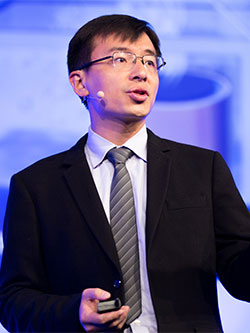
Prof. Jia Zhu
College of Engineering and Applied Sciences
Nanjing University
jiazhu@nju.edu.cn
Dr. Jia Zhu is a Professor at College of Engineering and Applied Sciences, Nanjing University. His scientific research interest is in the area of nanophotonics and nanoscale heat transfer.
Dr. Zhu obtained his bachelor in Physics at Nanjing University, received his M.S. and Ph.D. in Electrical Engineering from Stanford University. He worked as a postdoctoral fellow at University of California, Berkeley and Lawrence Berkeley National Lab.
He has received several prestigious awards including: Explorer Prize (2020), NSFC Young Investigator Award (2019), Tan Kah Kee Young Scientist Award (2018), OSA Young Investigator Award (2017), Dupont Young Professor Award (2016), MIT Tech Review TR35 award (2016). He has published over 100 papers in prestigious journals (Nature, Nature series, National Science Review, Science Advances, Joule, PNAS etc.). He has delivered over 50 keynote/invited talks at leading research institutions and international conferences. He is a fellow of Optical (OSA), Royal Society of Chemistry, and serves as a managing editor of Nanophotonics, editorial board members of Advanced Photonics and Nano Research.
Title: Manipulating the flow of light & heat at nanoscale
Abstract: Light and heat are the two most common and widely used energy in the society. Nanostructures with carefully tailored properties can be used to manipulate the flow of light and heat, to enable novel devices and functionalities in an unconventional manner. In this talk, I will present three examples.
The first example is about water. Water scarcity is one of the most pressing global challenges. I will present our recent progress in interfacial solar vapor generation and its related applications. We report that efficient and broad-band plasmonic absorber can be fabricated through a three dimensional self-assembly process. Inspired by the transpiration process in plants, we further report an artificial transpiration device with a unique design of two dimensional water path. The energy transfer efficiency of this artificial transpiration device is independent of water quantity, a signature of interfacial solar evaporation. At the end, we would like to demonstrate that this type of interfacial solar vapor generations can have direct implications in various fields such as solar desalination, zero liquid discharge, sterilization and power generations.
The second example is about passive cooling. Radiative cooling which sends heat to space through atmospheric transparency window without any energy consumption, is attracting significant attention. For radiative cooling to achieve high cooling performance, it is ideal to have a selective emitter, with an emissivity dominant in the atmospheric transparency window. However, so far scalable production of radiative cooling materials with selective emissivity has not been realized. Here I will present a hierarchical design for a selective thermal emitter to achieve high performing all-day radiative cooling. Moreover, it is revealed that this hierarchically designed selective thermal emitter shows significant advantage if being applied to alleviate Global Warming or to regulate temperature of the Earth-like planet.
The third example is about integrated photonics. Plasmonics combining the advantages of the speed of light and the size of electron, has long been pursued as promising candidates for integrated photonics. However, the loss of plasmonic materials has long been the primary road blocker for its widespread implementations. Here I report the first experimental demonstration of alkali metal as high performing plasmonic materials. Because of low loss property, a room temperature sodium based plasmonic nanolaser with a record low threshold is demonstrated. In addition, as alkali metal also possesses unique electrochemical properties, alkali metal plasmonics at the intersect of plasmonics and electrochemistry, open up tremendous opportunities for both information and energy storage.